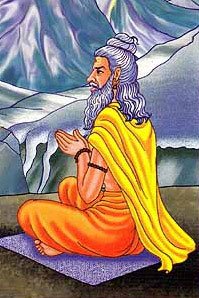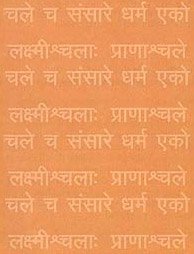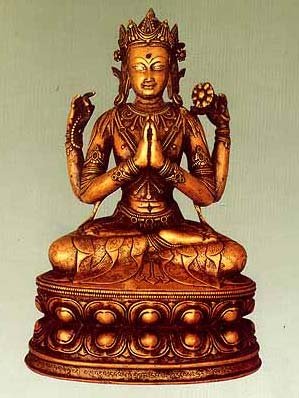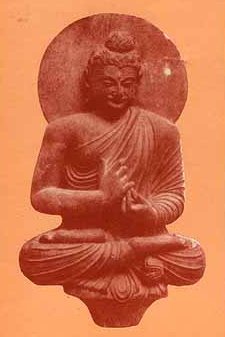Samutthita, Samuṭṭhita: 11 definitions
Introduction:
Samutthita means something in Buddhism, Pali, Hinduism, Sanskrit. If you want to know the exact meaning, history, etymology or English translation of this term then check out the descriptions on this page. Add your comment or reference to a book if you want to contribute to this summary article.
In Hinduism
Purana and Itihasa (epic history)
Source: archive.org: Shiva Purana - English TranslationSamutthita (समुत्थित) refers to “that (misery) which is born from”, according to the Śivapurāṇa 2.3.24 (“Śiva consents to marry Pārvatī”).—Accordingly, as Śiva said to Viṣṇu: “[...] I know the sufferings you undergo from [i.e., samutthita] the demon Tāraka. I shall remove them. Truth, I tell you the truth. Although I am not interested at all in dalliance I shall marry Pārvatī for begetting a son. O gods, all of you go back to your respective abodes fearlessly. I shall achieve your task. In this respect you need not be anxious at all. [...]”.

The Purana (पुराण, purāṇas) refers to Sanskrit literature preserving ancient India’s vast cultural history, including historical legends, religious ceremonies, various arts and sciences. The eighteen mahapuranas total over 400,000 shlokas (metrical couplets) and date to at least several centuries BCE.
Vedanta (school of philosophy)
Source: ORA: Amanaska (king of all yogas): (Advaita Vedanta)Samutthita (समुत्थित) refers to “having transcended (all thought)”, according to the Māṇḍūkyopaniṣatkārikā 3.37.—Accordingly, while discussing the no-mind state: “Devoid of all expression and having transcended all thought (sarvacintā-samutthita), Samādhi is very peaceful, its light perpetually [illuminates], [and it is] immovable and fearless”.

Vedanta (वेदान्त, vedānta) refers to a school of orthodox Hindu philosophy (astika), drawing its subject-matter from the Upanishads. There are a number of sub-schools of Vedanta, however all of them expound on the basic teaching of the ultimate reality (brahman) and liberation (moksha) of the individual soul (atman).
In Buddhism
Mahayana (major branch of Buddhism)
Source: academia.edu: A Study and Translation of the GaganagañjaparipṛcchāSamutthita (समुत्थित) refers to “originating from”, according to the Gaganagañjaparipṛcchā: the eighth chapter of the Mahāsaṃnipāta (a collection of Mahāyāna Buddhist Sūtras).—Accordingly, “[Bringing all beings to maturity (sarvasatva-paripācana)] [...] Again he thinks: ‘what is called ‘living being’ is a misunderstanding. Because of being occupied with the view of cause, ignorance, existence, thirst, and unreal mental constructions, it is called ‘living being’. However, the Bodhisattva still teaches the dharma to living beings in order to get rid of vices which originate from misunderstanding (viparyāsa-samutthita-kleśaprahāṇa), and he does not forget substances. Since he is devoid of a living being, and detached from a living being, he brings living beings to maturity. Thus the Bodhisattva brings living beings to maturity by the original purity”.

Mahayana (महायान, mahāyāna) is a major branch of Buddhism focusing on the path of a Bodhisattva (spiritual aspirants/ enlightened beings). Extant literature is vast and primarely composed in the Sanskrit language. There are many sūtras of which some of the earliest are the various Prajñāpāramitā sūtras.
Languages of India and abroad
Pali-English dictionary
Source: Sutta: The Pali Text Society's Pali-English DictionarySamuṭṭhita, (pp. of samuṭṭhahati) arisen, originated, happened, occurred J. II, 196; Dhs. 1035. (Page 687)

Pali is the language of the Tipiṭaka, which is the sacred canon of Theravāda Buddhism and contains much of the Buddha’s speech. Closeley related to Sanskrit, both languages are used interchangeably between religions.
Sanskrit dictionary
Source: DDSA: The practical Sanskrit-English dictionarySamutthita (समुत्थित).—p. p.
1) Risen, raised.
2) Recovered, cured.
3) Arisen, produced, born.
Source: Cologne Digital Sanskrit Dictionaries: Shabda-Sagara Sanskrit-English DictionarySamutthita (समुत्थित).—mfn.
(-taḥ-tā-taṃ) 1. Risen, got up. 2. Increased. 3. Derived or obtained from. 4. Cured, healed. E. sam and ud before sthā to stay, kta aff.
Source: Cologne Digital Sanskrit Dictionaries: Cappeller Sanskrit-English DictionarySamutthita (समुत्थित).—[adjective] risen, raised, high; sprung or produced from ([ablative]), appeared, grown (wings); ready or prepared for ([locative] or infin.).
Source: Cologne Digital Sanskrit Dictionaries: Monier-Williams Sanskrit-English Dictionary1) Samutthita (समुत्थित):—[=sam-utthita] [from samut-thā] mfn. risen up together, risen, raised (as dust), towering above (as a peak), surging (as waves), gathered (as clouds), [Mahābhārata; Kāvya literature etc.] appeared, grown, sprung or obtained or derived from ([ablative] or [compound]; dhanaṃ daṇa-samutthitam, ‘money derived from fines’), [Śvetāśvatara-upaniṣad; Manu-smṛti; Mahābhārata] etc.
2) [v.s. ...] ready, prepared for ([locative case]), [Mahābhārata; Rāmāyaṇa; Bhāgavata-purāṇa]
3) [v.s. ...] one who withstands all (opponents), [Rāmāyaṇa]
4) [v.s. ...] cured, healed, [Horace H. Wilson]
5) [v.s. ...] swollen up, [Monier-Williams’ Sanskrit-English Dictionary]
Source: Cologne Digital Sanskrit Dictionaries: Yates Sanskrit-English DictionarySamutthita (समुत्थित):—[(taḥ-tā-taṃ) p.] Raised up; risen, increased; arising from.
Source: DDSA: Paia-sadda-mahannavo; a comprehensive Prakrit Hindi dictionary (S)Samutthita (समुत्थित) in the Sanskrit language is related to the Prakrit word: Samuṭṭhia.
Sanskrit, also spelled संस्कृतम् (saṃskṛtam), is an ancient language of India commonly seen as the grandmother of the Indo-European language family (even English!). Closely allied with Prakrit and Pali, Sanskrit is more exhaustive in both grammar and terms and has the most extensive collection of literature in the world, greatly surpassing its sister-languages Greek and Latin.
Kannada-English dictionary
Source: Alar: Kannada-English corpusSamutthita (ಸಮುತ್ಥಿತ):—
1) [adjective] raised up; elevated; moved to a higher level.
2) [adjective] returned to health; recovered.
3) [adjective] happened; occured.
--- OR ---
Samutthita (ಸಮುತ್ಥಿತ):—
1) [noun] that which is raised, elevated or hoisted at a higher level.
2) [noun] a man who has stood up, raised (from sitting or reclining position).
Kannada is a Dravidian language (as opposed to the Indo-European language family) mainly spoken in the southwestern region of India.
See also (Relevant definitions)
Partial matches: Utthita, Sam.
Ends with: Akandasamutthita, Cintasamutthita, Sarvacintasamutthita.
Full-text: Samuttheya, Samutthia, Pabhavita, Samutthit, Samutthahati, Sarvacinta, Avari, Abhisastha, Viparyasa, Parikalpa, Pratitya, Padma, Dhatu, Stha.
Relevant text
Search found 6 books and stories containing Samutthita, Sam-utthita, Samuṭṭhita; (plurals include: Samutthitas, utthitas, Samuṭṭhitas). You can also click to the full overview containing English textual excerpts. Below are direct links for the most relevant articles:
Garga Samhita (English) (by Danavir Goswami)
Verse 1.13.27 < [Chapter 13 - The Liberation of Pūtanā]
Verse 6.6.32 < [Chapter 6 - The Yādavas’ Victory When Śrī Rukmiṇī is Kidnapped]
Verse 2.5.4 < [Chapter 5 - The Liberation of Bakāsura]
Bhajana-Rahasya (by Srila Bhaktivinoda Thakura Mahasaya)
Text 8 < [Chapter 3 - Tṛtīya-yāma-sādhana (Pūrvāhna-kālīya-bhajana–niṣṭhā-bhajana)]
Text 6 < [Chapter 3 - Tṛtīya-yāma-sādhana (Pūrvāhna-kālīya-bhajana–niṣṭhā-bhajana)]
Chaitanya Bhagavata (by Bhumipati Dāsa)
Verse 2.41 < [Chapter 2 - The Lord’s Manifestation at the House of Śrīvāsa and the Inauguration of Saṅkīrtana]
Mahabharata (English) (by Kisari Mohan Ganguli)
Section LIV < [Bhagavat-Gita Parva]
Consciousness in Gaudapada’s Mandukya-karika (by V. Sujata Raju)
Manas in waking, dream and deep sleep and the realization of No-Mind < [Chapter 5: A Study of Māṇḍūkya Kārikā: Advaita Prakaraṇa]
Sushruta Samhita, volume 1: Sutrasthana (by Kaviraj Kunja Lal Bhishagratna)